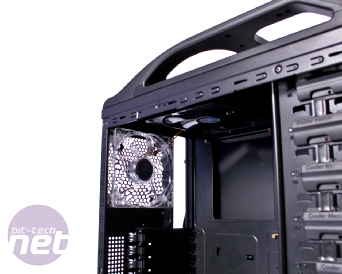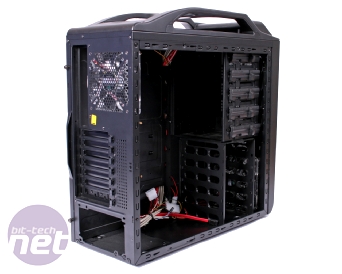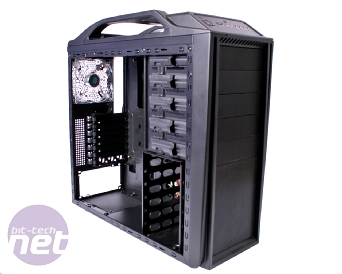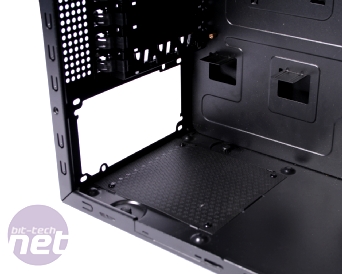
More Interior
Another positive is the Scout’s extremely simple hard disk drive mounting system. The case ships with a bundle of clips which fit, toollessly into the screw holes along the side of your hard disk, before sliding into the hard disk mounting cage and securing into place. While it lacks any sort of vibration dampening, it’s extremely easy to perform hard drive maintenance, and the straight-on mounting means you won’t have to gut your system if you need to swap a drive out.Cooling wise the Scout packs a similar cooling layout to a number of cases that we’ve looked at in the past, with a pair of exhaust fans squeezed into the top left corner (1x120mm and 1x140mm) and a front 120mm fan acting as an intake. Due to the small internal dimensions, this layout means the CPU socket, regardless of cooler, is flanked on two sides by exhaust fans, significantly enhancing CPU cooling.
However, this design does have its flaws, most notably with the cramped nature of the case, especially around the top of the motherboard. With such little clearance between motherboard and cooling fans, installing very large CPU coolers can be difficult or in the case of extremely large or wide coolers like the Thermalright Ultra Extreme 120, impossible without the removal of the roof mounted 140mm cooling fan. However Cooler Master’s now standard inclusion of a large cut-out beneath the CPU socket to simplify fitting back plate mounted heatsinks will help make things easier when it comes to testing and fitting your cooler of choice.
There’s also a rather unique inclusion in the form of a security expansion blanking plate. The plate is fitted with hooks and numerous cable routing holes, with the idea being to route the USB cables of your peripherals through the plate, securing them to the case and deterring sticky fingered LAN thieves (yes, really). While the usefulness of this feature at a LAN party is undeniable (unless you use wireless peripherals of course), like the case handle, in everyday use its worth is lessened.
The power supply mounting has been placed in the floor of the case, with a 120mm grilled section, covered with a thin removable mesh dust filter allowing 120mm fan cooler PSUs to draw cool air directly from outside of the chassis. The inclusion of a dust filter here is vital considering the low height of the case afforded by the four rubber case feet, although those concerned by the possible limited airflow to their PSU can simply mount it upside down, drawing air from inside the case instead.
Sadly though those not using a modular power supply will find there are few places to hide the trail of unused PSU cables inside the Scout. While its big brother the Sniper has specially shaped side panels, bowed in the middle to accommodate bunches of cables, the Scout is thinner across and lacks these spaces in its side panels, making hiding unwanted cables a real headache. It’s a stark contrast to the fabulous pre-tidied front panel and fan power cabling and while we recognise that the majority of modern PSUs are modular, it is still frustrating.
While tidying up the cabling might have been difficult though, actually fitting our core hardware was mercifully straight forward. Even though there’s little room around the standard ATX motherboard mounting installing our motherboard, replete with CPU and memory was straightforward. There’s room for even the largest of 10.5” graphics cards (albeit with a little giggling, and using such a large card will likely make the bottom 5.25” drive bay inaccessible) and the PSU was fitted into place and mounted with a minimum of fuss and bother.

MSI MPG Velox 100R Chassis Review
October 14 2021 | 15:04












Want to comment? Please log in.